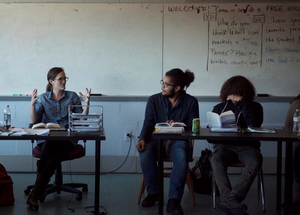“Early college” programs are not a new idea but have experienced rapid growth in recent years. And the term “early college” has expanded to include a range of different activities, Emily Deruy notes in an article for the Atlantic.
 Sometimes it means giving high-school students access to college classes online, sometimes it involves having kids spend half their day at high school and half on a nearby college campus; sometimes students take vocational classes while in high school, and sometimes they take liberal arts classes.
Sometimes it means giving high-school students access to college classes online, sometimes it involves having kids spend half their day at high school and half on a nearby college campus; sometimes students take vocational classes while in high school, and sometimes they take liberal arts classes.
For her article, Deruy visits a high school in Baltimore that is part of the Bard Early College Network.
At most Bard locations, students essentially complete ninth and 10th grade and then transition to a two-year, tuition-free college curriculum in the liberal arts and sciences. At the end, most have an associate of arts degree (about 60 transferable credits) and a high-school diploma. Instead of having to leave campus to go to an affiliated college, Bard students are generally taught in all four years by teachers with Ph.D.s. Unlike at Simon’s Rock, the schools are public and students do not have to pay, meaning they can earn an associate’s degree at no cost. Most of the expense is covered by the partner school districts, but Bard does also receive some private funding from groups like the Carnegie Corporation.
For the Summer 2016 issue of Education Next, Joanne Jacobs wrote about Salt Lake City’s Innovations Early College High School, a blended learning school with a “career-tech” focus.
Innovations occupies the corner of an airy new building on the South City campus of Salt Lake Community College (SLCC), along with the district’s Career and Technical Center (CTC). The state reported that last year about 1 in 10 Innovations juniors and seniors took community-college classes and more than half took courses through the CTC, whose offerings range from computer programming and CD graphics to barbering and nail design. In addition, students may ride a shuttle bus to their local high school to participate in classes or extracurriculars, such as choir, band, foreign language, or sports.
As Deruy concludes her article
The coming years stand to bring more rapid growth, both within the network and more broadly. The concept was recently acknowledged in federal legislation for the first time, and the U.S. Education Department is exploring the use of Pell grants, federal funds low-income students use to pay for college, for such programs. It’s a concept that actually enjoys some bipartisan support. In January, the College in High School Alliance coalition, which counts Bard along with groups like Jobs for the Future and the National Alliance of Concurrent Enrollment Partnerships as members of its steering committee, will officially launch with the aim of promoting policies that advance such programs.
“The high-school diploma is a vestigial credential,” Bickford said. Now, he added, the goal for proponents is to show that quality early-college models are scalable, and that they can help reduce achievement gaps and dropout rates not by dumbing things down, but by challenging kids and exposing them to new opportunities.
– Education Next


